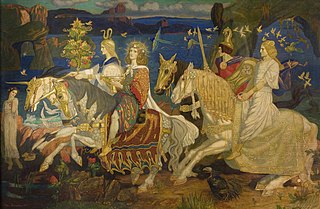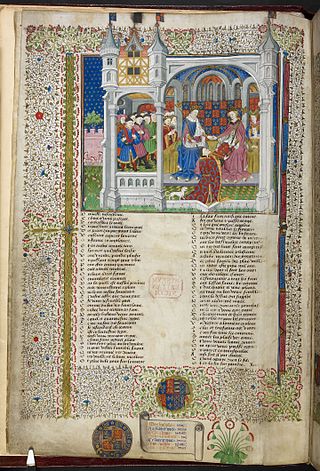
Irish mythology is the body of myths indigenous to the island of Ireland. It was originally passed down orally in the prehistoric era. In the early medieval era, some myths were transcribed by Christian monks, who heavily altered and Christianised the myths. Irish mythology is the best-preserved branch of Celtic mythology.

The Matter of Britain is the body of medieval literature and legendary material associated with Great Britain and Brittany and the legendary kings and heroes associated with it, particularly King Arthur. The 12th-century Welsh cleric Geoffrey of Monmouth's Historia Regum Britanniae, widely popular in its day, is a central component of the Matter of Britain.

Reynard the Fox is a literary cycle of medieval allegorical Dutch, English, French and German fables. The first extant versions of the cycle date from the second half of the 12th century. The genre was popular throughout the Late Middle Ages, as well as in chapbook form throughout the Early Modern period.

The chanson de geste is a medieval narrative, a type of epic poem that appears at the dawn of French literature. The earliest known poems of this genre date from the late 11th and early 12th centuries, shortly before the emergence of the lyric poetry of the troubadours and trouvères, and the earliest verse romances. They reached their highest point of acceptance in the period 1150–1250.
Garin de Monglane is a fictional aristocrat who gives his name to the second cycle of Old French chansons de geste, La Geste de Garin de Monglane. His cycle tells stories of fiefless lads of noble birth who went off seeking land and adventure fighting the Saracens.
According to the medieval poet Jean Bodel, the Matter of Rome is the literary cycle of Greek and Roman mythology, together with episodes from the history of classical antiquity, focusing on military heroes like Alexander the Great and Julius Caesar. Bodel's division of literary cycles also included the Matter of France and the Matter of Britain. The Matter of Rome includes the Matter of Troy, consisting of romances and other texts based on the Trojan War and its legacy, including the adventures of Aeneas.
The Matter of France, also known as the Carolingian cycle, is a body of literature and legendary material associated with the history of France, in particular involving Charlemagne and his associates. The cycle springs from the Old French chansons de geste, and was later adapted into a variety of art forms, including Renaissance epics and operas. Together with the Matter of Britain, which concerned King Arthur, and the Matter of Rome, comprising material derived from and inspired by classical mythology, it was one of the great European literary cycles that figured repeatedly in medieval literature.

The Ulster Cycle, formerly known as the Red Branch Cycle, is a body of medieval Irish heroic legends and sagas of the Ulaid. It is set far in the past, in what is now eastern Ulster and northern Leinster, particularly counties Armagh, Down and Louth. It focuses on the mythical Ulster king Conchobar mac Nessa and his court at Emain Macha, the hero Cú Chulainn, and their conflict with the Connachta and queen Medb. The longest and most important tale is the epic Táin Bó Cúailnge. The Ulster Cycle is one of the four 'cycles' of Irish mythology and legend, along with the Mythological Cycle, the Fianna Cycle and the Kings' Cycle.

Lugalbanda was a deified Sumerian king of Uruk who, according to various sources of Mesopotamian literature, was the father of Gilgamesh. Early sources mention his consort Ninsun and his heroic deeds in an expedition to Aratta by King Enmerkar.

As a literary genre, the chivalric romance is a type of prose and verse narrative that was popular in the noble courts of high medieval and early modern Europe. They were fantastic stories about marvel-filled adventures, often of a chivalric knight-errant portrayed as having heroic qualities, who goes on a quest. It developed further from the epics as time went on; in particular, "the emphasis on love and courtly manners distinguishes it from the chanson de geste and other kinds of epic, in which masculine military heroism predominates."
The 12th-century chanson de geste of Garin le Loherain, together with the slightly later Girbert de Metz, form the core and initial parts of the so-called Lorraine cycle, which was expanded in the 13th century by a prequel and three sequels. The cycle is one of the fiercest and most sanguinary narratives left by the trouvères. This local cycle of Lorraine appears to have a historical basis. Although the actions as recorded cannot be identified with specific historical events, the poems are valuable depictions of the savage feudal wars in the 11th and 12th centuries.

Medieval French literature is, for the purpose of this article, Medieval literature written in Oïl languages during the period from the eleventh century to the end of the fifteenth century.
La Geste de Garin de Monglane is the second cycle of the three great cycles of chansons de geste created in the early days of the genre. It centres on Garin de Monglane. One of its main characters is William of Gellone.
Early Irish literature, is commonly dated from the 8th or 9th to the 15th century, a period during which modern literature in Irish began to emerge. It stands as one of the oldest vernacular literature in Western Europe, with its roots extending back to late antiquity, as evident from inscriptions utilizing both Irish and Latin found on Ogham stones dating as early as the 4th century. The early Irish literary tradition flourished through the Medieval Irish period, and its literary output showcases a blend of indigenous storytelling, myth, and historical narratives. Notably, this period saw the development of a full-scale vernacular written literature expressed in a diverse range of literary genres.
French folklore encompasses the fables, folklore, fairy tales and legends of the French people.
Girart de Vienne is a late twelfth-century (c.1180) Old French chanson de geste by Bertrand de Bar-sur-Aube. The work tells the story of the sons of Garin de Monglane and their battles with the Emperor Charlemagne, and it establishes the friendship of the epic heroes Olivier and Roland.

Galiens li Restorés, or Galien le Restoré or Galien rhétoré, is an Old French chanson de geste which borrows heavily from chivalric romance. Its composition dates anywhere from the end of the twelfth century to the middle of the fourteenth century. Five versions of the tale are extant, dating from the fifteenth century to the sixteenth century, one in verse and the others in prose. The story—which is closely linked to the earlier chansons de gestePèlerinage de Charlemagne and The Song of Roland —tells of the adventures of Galien, son of the hero Olivier and of Jacqueline, the daughter of the (fictional) emperor Hugon of Constantinople.

Celtic mythology is the body of myths belonging to the Celtic peoples. Like other Iron Age Europeans, Celtic peoples followed a polytheistic religion, having many gods and goddesses. The mythologies of continental Celtic peoples, such as the Gauls and Celtiberians, did not survive their conquest by the Roman Empire, the loss of their Celtic languages and their subsequent conversion to Christianity. Only remnants are found in Greco-Roman sources and archaeology. Most surviving Celtic mythology belongs to the Insular Celtic peoples. They preserved some of their myths in oral lore, which were eventually written down by Christian scribes in the Middle Ages. Irish mythology has the largest written body of myths, followed by Welsh mythology.

The Talbot Shrewsbury Book is a very large richly-illuminated manuscript made in Rouen (Normandy) in 1444/5. It was presented by John Talbot, 1st Earl of Shrewsbury to the French princess, Margaret of Anjou, in honour of her betrothal to King Henry VI. It contains a unique collection of fifteen texts in French, including chansons de geste, chivalric romances, treatises on warfare and chivalry, and finally the Statutes of the Order of the Garter. The work is an excellent example of book production in Rouen in the mid-fifteenth century and provides a rare insight into the political views of the English military leader and close confidant of the crown, John Talbot.









